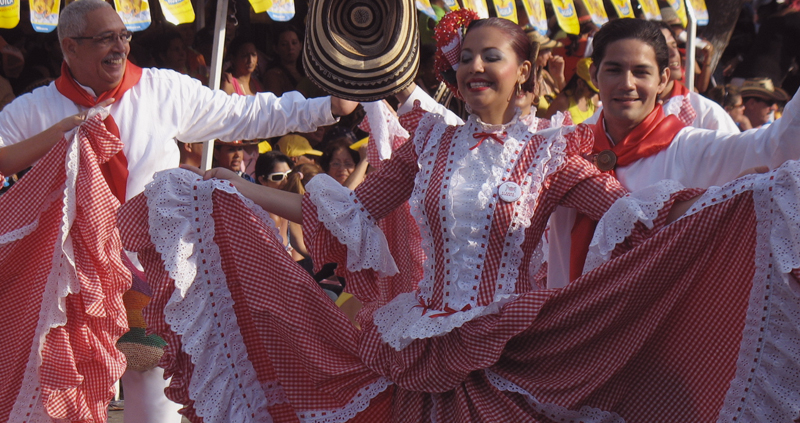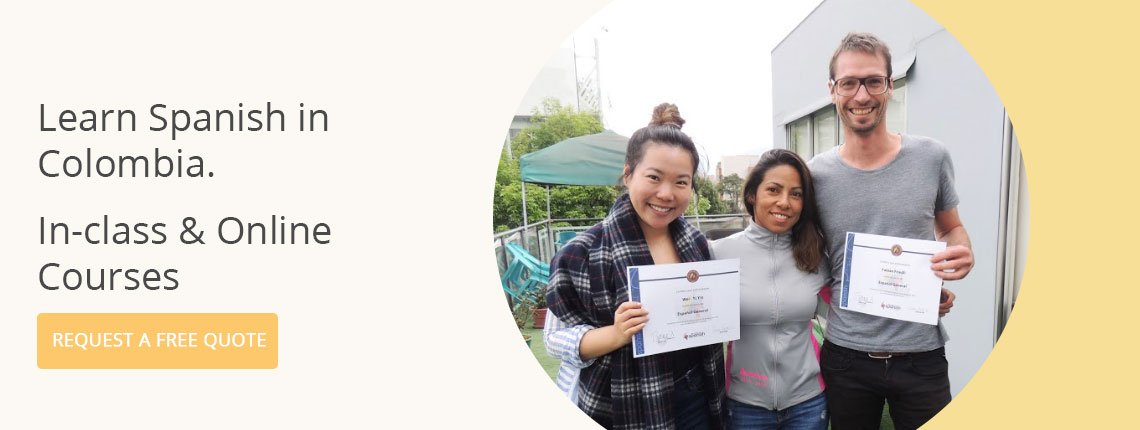10 Colombian music genres you need to know about!
It would be difficult to imagine Colombia without music, wouldn’t it?
In Colombia, music is passion, it’s a sensory experience.
As we usually say, music is in our blood -“Llevamos la música en la sangre”-
And, yes, it is literally in our blood!
Our music is a blend of Spanish and European influences with indigenous sounds and African beats. Read also our post People of Colombia, as diverse as their country
In Colombia, we don’t just hear the music, we feel it and we live it.
Our passion for music and our love for dancing is actually one of the things people like the most about Colombians.
“Music is an important part of the Colombian culture. It is a way of expressing emotions, sharing discomfort or showing love to friends and family. It is a way of showing their pride for their roots, and a way of living in the moment.”
Colombian music has a rich and diverse cultural heritage. Every part of Colombia moves to a different sound; each region has its own rhythms.
There are more than 1,025 folk rhythms grouped into 157 different genres. That is why our country is known by “the land of the thousand rhythms”.
It is not surprising, then, that ProColombia has outlined one of the country’s promotion campaign based on our musical diversity. The campaign is called Feel the Rhythm.
Also, in 2018, ProColombia together with UNWTO and Sound Diplomacy released a white paper on music and tourism, called Music is the new gastronomy. It looks at music as a primary driver of tourism.
Now you know, no trip to Colombia is complete without music!
So, if you are planning to visit Colombia, make sure you get familiar with our music and with our language.
There is no better way to enjoy Colombian culture than by dancing our music and talking to our people!
Let us now take you to a Colombian music journey. Discover the 10 most popular Music Genres and Styles from our country:
Caribbean region
1. Cumbia
Cumbia is perhaps the country’s most popular music genre. It originated as a courtship dance among West African slaves.
Initially, Cumbia was performed using only drums and claves. Then, it incorporated other influences from the indigenous Kogui and Kuna tribes (flutes and percussion). As well as from Spaniards (European guitars), and Germans (accordion).
Even if you have not visited Colombia, you have probably heard Cumbia beats and seen Cumbia dance. Shakira, one of the country’s most recognized artists has been a great ambassador of this genre.
The following video explains how and where Cumbia began.
If you want to learn more about Cumbia, watch also videos from Los Gaiteros de San Jacinto.
2. Bullerengue
Bullerengue is a Cumbia-based style traditionally sung by women. It also has African and Spanish roots and influences.
Some of its main characteristics include a strong emphasis in rhythm and improvisation over melody, large groups of musicians, and a call-and-response interaction between the lead singer, known as “cantadora” and a choir.
Two of the most famous bullerengue singers are Petrona Martinez and Totó La Momposina. Thanks to them, Bullerengue recognized internationally.
3. Vallenato
Along with Cumbia, Vallenato is one of the most popular Colombian music genres.
Vallenato is traditionally played with an indigenous Gaita flute, a caja drum, a guacharaca, and an accordion.
This genre is characterized by its literary content and narrative style. To such extent that Gabriel García Márquez, Colombian writer, once said that this music had been woven with the same strand of his novels and that the most famous of them “One hundred years of Solitude” was nothing more than a 300-pages Vallenato.
Vallenato was considered the music of the lower class and farmers. But, after the mid-20th century, it gradually started penetrating through every social group.
In recent years, artists like Carlos Vives have begun mixing vallenato with contemporary rhythms, developing a modern variant.
4. Champeta
Champeta is more than a music genre or a dance; it’s a movement. It began in the early ’80s among Afro-Colombians, mainly Cartagena de Indias.
The word “champeta” originally denoted a kind of knife used in the region at work, in the kitchen or, sometimes, even as an offensive weapon. Then, the term “champetudo” started to be used by the elites of the city to refer to those residents of the more outlying districts of Cartagena, who tended to be poorer and of African descent.
Champeta is a fusion of rhythms from Africa (soukous, highlife, mbaqanga, juju), the Antilles (ragga, compás haitiano), and music of Indigenous and Afro-Colombian origins (bullerengue, mapalé, zambapalo and chalupa).
Champeta also has evolved during the last decades. It passed from being a music genre and dance of the so-called “poor”; to being even one of the favorite music genres of the middle and upper classes in Bogotá.
Pacific Region
Pacific music includes a large number of music styles depending on the region.
Music from the north is more energetic, while music from the south is characterized by a mellow timbre from the wooden marimba.
5. Currulao
Currulao is the most renowned Pacific music genre.
It is mainly played by a group of musicians. The Currulao rhythm is created by striking the skin of the African drum called “cununo” with the one’s hand and tapping the side of the drum with a small stick. But the main instrument is perhaps the Colombian marimba, a wooden xylophone that resembles the African balafon.
Check out the following video and learn how Currulao sounds like
In recent years Currulao has gained popularity amidst young musicians from the region. They have included the rhythms and instruments in their contemporary compositions to promote their region and to show how proud they are of being Afro-Colombians and being from the Pacific.
Watch for instance Herencia de Timbiqui and Choquibtown
Andean Region
6. Bambuco
Bambuco is a folk genre that originated in the Andean highlands. It is pretty much a fusion between Spanish and indigenous styles, although it has some African roots as well.
It is traditionally performed with a bandola, guitar or mandolin and a small 12-string instrument called a tiple.
Rhythmically is related to the Currulao, which is called some times Bambuco Viejo (Old Bambuco). However, Andean Bambuco has a more melancholic spirit.
Bambuco was popular all over Colombia between the 1920s and the 1930s. Unfortunately, its popularity is not as it used to be but its rhythms have influenced many other modern genres.
Interestingly, during the last years, traditional music has gained again some popularity thanks to young musicians. One of them is Katie Jaimes, who was born in south Ireland but when she was two years old her family moved to Colombia where she grew up and lives presently.
Check out one of her latest videos with Spanish subtitles so that you can practice your Spanish!
7. Salsa
Those from Colombia probably are used to hearing “are you from Colombia? So you dance salsa, can you teach me?”
Although Salsa is not originally a Colombian music genre, it is very important to mention it due to its great influence in our culture.
There is not a trip to Colombia without music, there is definitely not a trip to Colombia without salsa.
Colombian salsa started developing in the country during the 1960s when Cali’s upper class organized every year a carnival to commemorate the crop of sugarcane. This music style gained quite some popularity among the “caleños” (people from Cali), they introduced their own steps and speed. Was then when Colombian Salsa or Salsa Caleña was born.
Unlike other salsa styles, in Colombian salsa, the upper body remains mostly rigid, with most of the movement occurring in the hips and legs.
Check out how Colombians dance salsa:
Over the years, like all the other genres, Colombian salsa has also evolved. New subgenres have been born. One of those is Salsa Choke. It is a genre-mixing Afro-based rhythm and traditional salsa with reggaeton.
Orinoquia Region
8. Musica Llanera and Joropo
Joropo is the traditional style from “música llanera” which literally translates to “music of the plains”. It is inspired by nature, landscapes, and the lifestyle the Colombian cowboys.
It is known for verbal contests called “contrapunteo”, the use of the harp as the lead instrument, and the fast-paced maracas.
Cholo Valderrama is one of the most popular artists performing Musica Llanera. Check out the following video and learn how it sounds like:
Insular Region
9. San Andrés and Providencia Islands rhythms
The music of the insular region is even more diverse than the music from the other regions. It also has African and European influences, but it also adds some Caribbean mixes.
The rhythms from the islands include Calipso, Compas, Foxtrot, Mazurka, Mento, Praise Hymn, Pasillo isleño, Polca, Quadrille, Reggae, Schottische, Soca, Vals isleño, and Zouk.
There is not one specific genre from the Colombian Insular region; the “traditional” rhythms are the blend of these.
Check out the following two videos from San Andrés and Providencia artists:
Creole group
Elkin Robinson
Did you hear any different language than Spanish in these songs? Yes, you are right! in this region, people also speak Creole and English.
Amazon Region
10. Amazon Rainforest Rhythms
The Amazon is the least populated and least developed region of Colombia, but it is one of the most biodiverse from Colombia and from the world.
Amazon rainforest is also known as being the Lungs of the Earth. It produces some of the world’s rarest and most unusual fruits and flavors. It is also home to numerous indigenous communities, sounds and rhythms.
There is not a specific genre or rhythm from this region. However, each year, at the end of November, and for three days, takes place the International festival of amazonense popular music finmupa “el pirarucu de oro”.
Check out the latest video of the Feel the Rhythm campaign about this region and let yourself mesmerized by the sounds of the indigenous flute and the images of the rainforest.
We hope you have enjoyed the Colombian music journey. Colombia is a culture that is best understood through its sounds.
We also hope that by watching these videos you are now more familiar with our music, our dances and our traditional dresses. Remember that even though music is an international language, learning Spanish will give you a great advantage when understanding the lyrics of the songs and understanding our culture.











